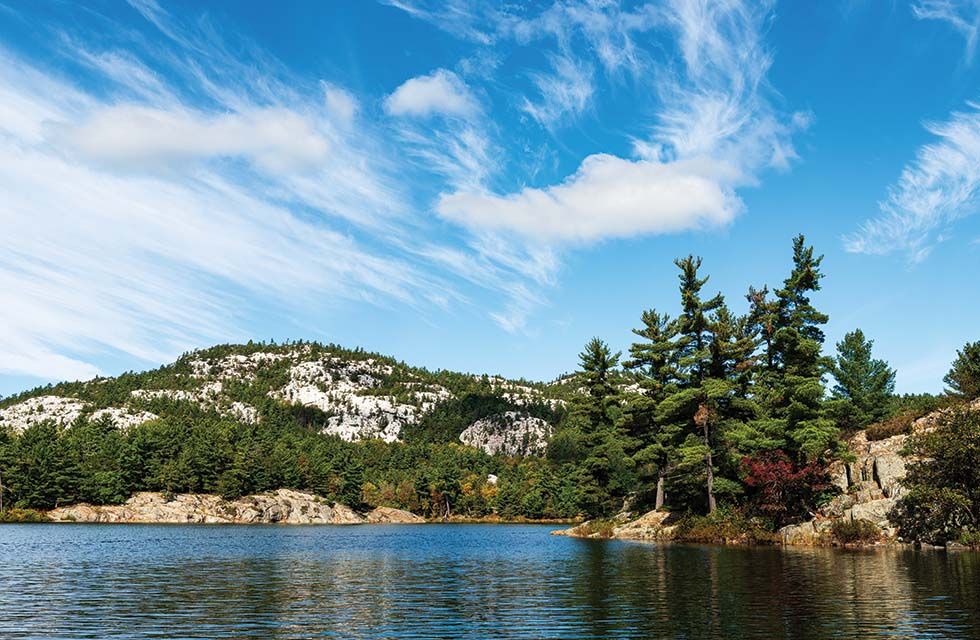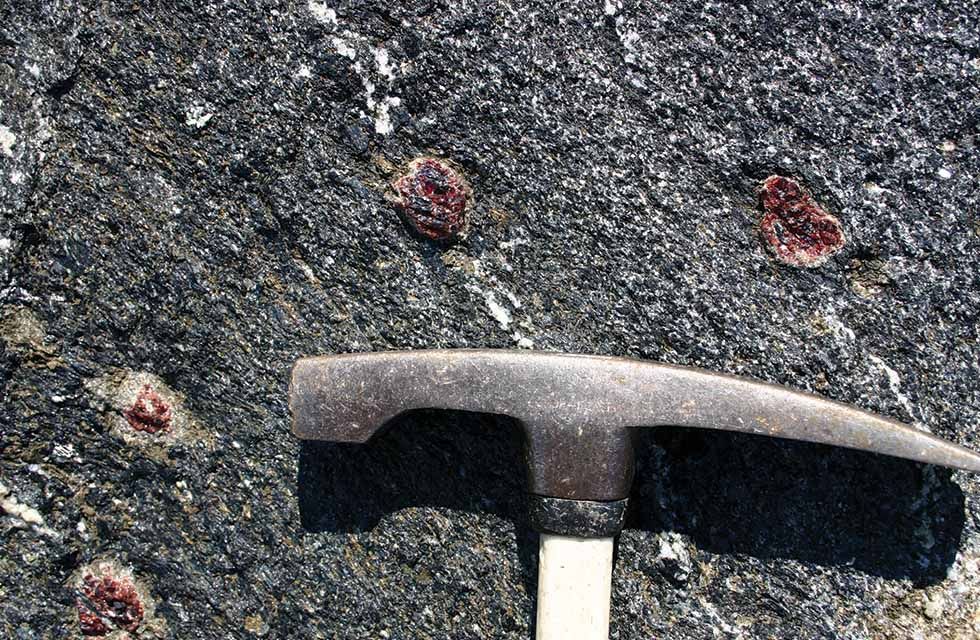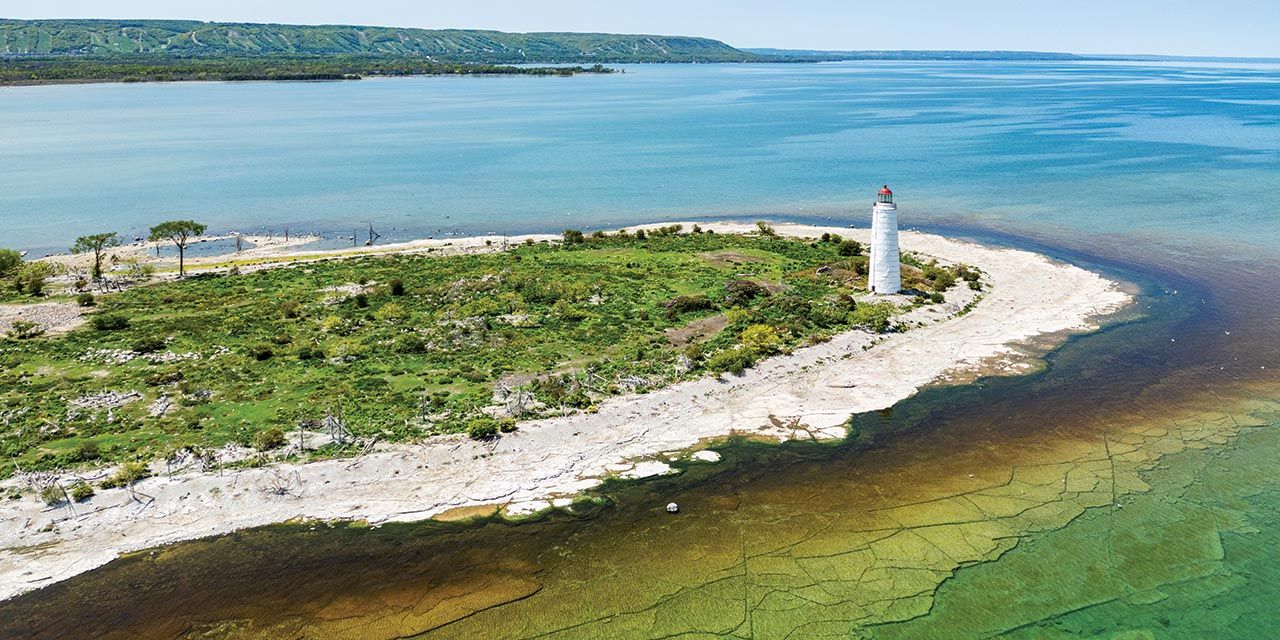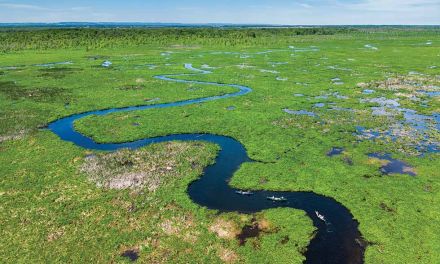A Billion Years in the Making
By Don Campbell | Photography by Clay Dolan & Nick Eyles
A grassroots initiative is working to secure UNESCO Global Geopark status for Georgian Bay, and the North Channel, aiming to protect its unique geology, promote education, and support sustainable development.
Nick Eyles kneels and points to a series of pink and gray lines running along a large, flat rock. “Right here, this is how you know it’s gneiss,” he says, running a finger along the veins of a rock created under immense heat and pressure around 1.3 billion years ago.
Eyles is giving a tour to a group of local residents and cottagers of Painted Rock, a windswept patch of granite located on the eastern shores of Georgian Bay, between Bayfield Inlet and the Naiscoot River. “What’s remarkable about this spot, besides its natural beauty, is that it offers a relatively accessible glimpse into the geological history of the region.”
The gneiss (pronounced nice) Eyles is pointing to was formed underneath an ancient mountain range the size of the Himalayas. At 25 kilometres below the surface and at temperatures reaching 1200 Celsius, the rock was stretched like toffee, giving it a signature look that appears to be painted on.
Painted Rock is emblematic of the countless significant geological sites that stretch across the Bay, and a big reason why Eyles, a geologist at the University of Toronto, is teaming up with a grassroots community group that wants to earn Georgian Bay a UNESCO Geopark designation.
“A UNESCO Global Geopark is not a park in the traditional sense,” explains Tony Pigott, executive director of the Georgian Bay Geopark initiative. “There’s no legal title, it won’t enforce rules or employ park wardens. Instead, the goal is to celebrate a region’s globally significant geological heritage while ensuring its future through protection, education and sustainable development.”
“UNESCO stands for places of global significance, and we believe Georgian Bay is right up there with any other significant natural site in the world,” he says.

The La Cloche Mountains’ white quartzite ridges in Killarney Provincial Park. Photo by Clay Dolan.
There are currently 213 Geoparks in 48 countries around the world, including five in Canada. They include places like Beaujolais, France, best known for its wine-making, and the Bay of Fundy between New Brunswick and Nova Scotia, known for its towering 300-foot ocean-side cliffs.
The Georgian Bay group is looking to include more than 49,850 sq km in the core area of the park — encompassing the entire Bay and its surrounding watersheds — which, if approved, would make it the largest Geopark by size in the world.
Pigott says the benefits of a Geopark include creating stronger, more resilient communities that are better prepared for rising population density and climate change, more jobs and economic development through sustainable ecotourism, as well as economic and cultural reconciliation with Indigenous communities around the Bay.
In addition to the respect and prestige attached to the UNESCO name, a Geopark comes with a robust conservation plan. Pigott says given the region is under intense pressure from population growth and climate change, it needs a coordinated approach to preserving its future. The group is currently raising awareness about the initiative by meeting with Indigenous and community organizations across the Bay, which is a key component to earning the designation.
The group says it recognizes that the Georgian Bay region is a significant place for many Indigenous Nations, and that they are fully committed to honouring treaties signed with the Crown and the United Nations Declaration on the Rights of Indigenous Peoples. In keeping with this promise, they will implement Indigenous Ways of Knowing to achieve a balanced perspective in conserving Georgian Bay.

Gneiss rocks found along the eastern shores of Georgian Bay. Photo by Nick Eyles.
Pigott is quick to point out that efforts to achieve a UNESCO designation will not create competition with other local conservation efforts across the region, rather it will connect these groups under a common cause.
“In this case, a high tide raises all boats,” he says. “We want to develop deep and meaningful partnerships with Indigenous and community groups so we can all work together to be stewards of the Bay.”
A unique element of the Georgian Bay Geopark initiative is the commitment to scientific research. As development pressures, particularly from an ever-expanding Greater Toronto Area, continue to increase, the group is committed to studying the Bay and its watersheds to have a better understanding of how it’s being impacted.
One proposed research project will combine water quality monitoring across the Bay with drone and satellite imagery. The result will be the most detailed database and assessment on the health of Georgian Bay’s water, watersheds and coastlines ever assembled. This data will be crucial for municipalities, Indigenous communities, federal and provincial agencies as well as environmental NGOs as they navigate future development around Georgian Bay.
Eyles, a resident of the Parry Sound District who has studied unique geological sites across the world, says he knows first-hand how globally significant the Bay is. “Georgian Bay is a global treasure with a 2.7-billion-year-old geological history,” he says. “It’s important we preserve this special place for future generations.” E







